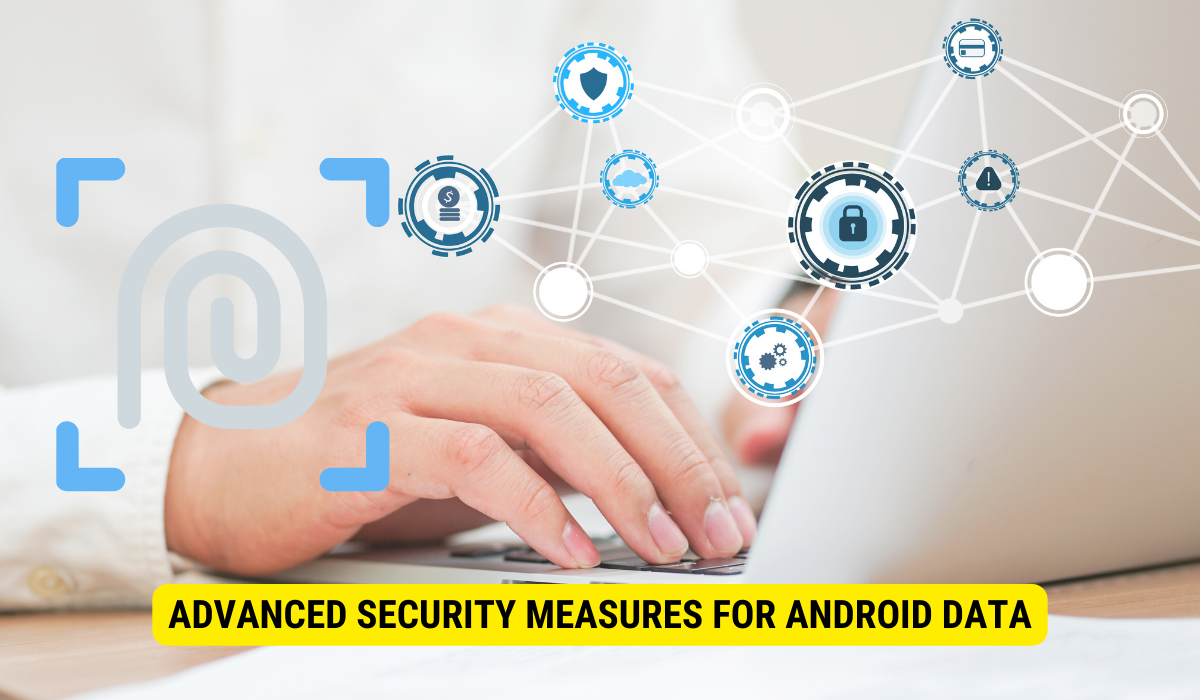To secure Android data:
- At Rest: Use strong passwords, enable full disk encryption, secure cloud storage, encrypt external storage, and back up data regularly.
- In Transit: Connect to secure Wi-Fi, use VPNs, ensure HTTPS, avoid suspicious links, and keep apps and OS updated.
Data security has become paramount in today’s digital age, where sensitive information is constantly transferred and stored on Android devices. Whether it is personal documents, financial information, or confidential business data, protecting Android data while at rest and in transit is crucial. I will delve into Android data security and provide practical tips and best practices to confirm your data remains safe from unauthorized access and potential breaches.
Understanding Android Data Security
Before we delve into securing Android data, it is important to understand the importance of data security and its key concepts. Adopting robust security measures to safeguard sensitive information is imperative in a world where hackers and cybercriminals constantly evolve tactics.
Data security is not just about protecting individual files or documents; it encompasses protecting data from unauthorized access, use, disclosure, disruption, modification, or devastation. The consequences of a data crack can be severe, ranging from identity theft, financial loss, and reputational damage to legal consequences. Therefore, ensuring the security of Android data is of utmost importance, both for individual users and organizations.
The Importance of Data Security
Data security is a critical aspect of our digital lives. With the increasing reliance on technology and the vast amount of sensitive information stored on Android devices, the need for robust data security measures has become more pressing than ever before. Hackers and cybercriminals are continually looking for vulnerabilities to exploit, making it crucial for individuals and organizations to stay one step ahead in protecting their data.
By implementing effective data security measures, individuals can have peace of mind knowing that their personal information, such as passwords, financial details, and private communications, is adequately protected. Similarly, organizations can safeguard their intellectual property, customer data, and trade secrets, preventing potential financial and reputational damage.
Key Concepts in Android Data Security
Regarding securing Android data, several key concepts need to be understood.
Authentication: Authentication is verifying a user’s or device’s identity before granting access to sensitive data. Strong authentication measures, such as unique passwords, biometric authentication, or two-factor authentication, help prevent unauthorized access to Android devices.
Executing multi-factor authentication adds an extra layer of security by requiring users to provide proof of their identity, such as a fingerprint or a one-time confirmation code sent to their mobile device. This significantly reduces the risk of illegal access, even if someone obtains the user’s password.
Authorization: Authorization grants or denies access to specific resources or actions based on the user’s authenticated identity. Android users can ensure that only authorized individuals can access their data by implementing robust authorization mechanisms.
For example, an individual may have different levels of access privileges within an organization. A regular employee may only access certain files and folders, while a manager or executive may have broader access rights. By carefully defining and enforcing authorization rules, organizations can stop unauthorized users from accessing sensitive information, reducing the risk of data breaches.
Encryption: Encryption involves encoding data using cryptographic algorithms to protect it from unauthorized access. Implementing robust encryption techniques ensures that even if data falls into the wrong hands, it remains unusable without the encryption key.
Android devices offer various encryption options, such as full-disk and file-based encryption. Full-disk encryption protects the entire device, including the operating system and all user data, while file-based encryption allows for more granular control over individual files and folders. By encrypting sensitive data, users can mitigate the risk of unauthorized access, even if their device is lost, stolen, or compromised.
Additionally, Android apps can also utilize encryption to protect data in transit. By employing secure communication protocols like HTTPS, apps can ensure that data transmitted between the device and servers remains encrypted and secure.
Securing Android Data at Rest
Data at rest refers to data stored on Android devices, such as internal storage, external SD cards, or cloud storage. Protecting data at rest is crucial, as unauthorized access to physical devices or storage can expose sensitive information to malicious actors.
What Does ‘Data at Rest’ Mean?
Data at rest refers to data not actively accessed or transmitted. It resides on storage media such as hard drives, solid-state drives, or cloud storage. This includes files, emails, application data, and other digital information stored on Android devices.
Steps to Secure Your Data at Rest
There are several steps you can take to secure your Android data at rest:
- Use Strong Passwords: Set a unique and complex password or PIN to lock your Android device. Avoid using easily guessable passwords, such as anniversaries or sequential numbers.
- Enable Full Disk Encryption: Android devices can encrypt the entire storage. Enable this feature to ensure that all your data is protected and cannot be accessed without the encryption key.
- Secure Cloud Storage: If you use cloud storage services to store your data, ensure that the provider offers strong encryption and robust security measures. Use a strong and unique password to access your cloud storage account.
- Secure External Storage: If you use external SD cards to store data, ensure they are also encrypted. Some Android devices offer the option to encrypt external storage, adding an extra security layer.
- Regularly Backup Data: Create backups of your important data regularly and store them securely. In the event of data loss or device theft, having backups ensures you can restore your data without any hassle.
Securing Android Data in Transit
Data in transit refers to data transmitted over networks or between devices. This includes browsing the internet, accessing email, or transferring files between devices. Protecting data in transit is vital to prevent unauthorized interception or tampering of sensitive information.
Understanding ‘Data in Transit’
Data in transit refers to data movement from one location or device to another. It can be transmitted through various mediums, such as Wi-Fi, cellular networks, or wired connections. When data is in transit, it is vulnerable to interception by attackers who may attempt to gain unauthorized access or manipulate the information.
Techniques for Securing Data in Transit
There are several techniques and best practices you can employ to secure your Android data in transit:
- Use Secure Wi-Fi Networks: Connect to secure and trusted Wi-Fi networks when accessing the internet or transferring data. Avoid using public or unsecured Wi-Fi networks, which may expose your data to eavesdropping or other malicious activities.
- Use Virtual Private Networks (VPNs): VPNs create a secure and encrypted connection between your Android device and the internet. A VPN protects your data from interception and ensures your online activities remain private.
- Enable HTTPS: When browsing websites or accessing online services, ensure that the websites use HTTPS protocol. HTTPS encrypts the data transmitted between your device and the website, making it difficult for attackers to intercept or modify the data.
- Be Cautious of Unknown or Suspicious Links: Avoid clicking on unknown or suspicious links received via email, SMS, or messaging apps. These associations may lead to malicious websites or apps that steal your data or install malware on your device.
- Keep Apps and Operating System Updated: Regularly update your Android device’s operating system and its installed apps. Updates often include security patches that fix susceptibilities and protect against potential threats.
Best Practices for Android Data Security
In addition to securing Android data at rest and in transit, it is essential to follow best practices to ensure comprehensive data security.
Regular Updates and Patches
Keep your Android device’s operating system, apps, and security software current. Regular updates often include patches that fix security vulnerabilities or address known issues.
Using Secure Networks
Avoid connecting to unsecured Wi-Fi networks, especially when accessing sensitive information or making financial transactions. Connect to trusted networks or use a VPN to ensure secure data transmission.
Advanced Security Measures for Android Data
While following best practices can significantly enhance Android data security, there are advanced security measures that can further protect sensitive information.
Encryption and Its Role in Data Security

Encryption protects data at rest and ensures that any data leaving the device remains secure. Encryption scrambles the data, making it unintelligible to unauthorized users. Utilize encryption techniques such as AES (Advanced Encryption Standard) to enhance the security of your Android data.
Utilizing VPNs for Enhanced Security
Virtual Private Networks (VPNs) offer an additional layer of security by encoding internet traffic and routing it through a secure server. This helps protect your data from potential interception or monitoring, especially when using public Wi-Fi networks.
By implementing these advanced security measures, you can establish a robust defense against potential threats and ensure the utmost security of your Android data.
Key Takeaways
- Data Encryption is Crucial: Enable full disk encryption for data at rest to protect your Android device from unauthorized access.
- Use Strong Passwords: Implement strong, unique passwords or PINs for your device and accounts to enhance security.
- Backup Your Data: Regular backups ensure you can recover your data in case of loss or theft of your device.
- VPN for Secure Transit: Utilize Virtual Private Networks (VPNs) to encrypt data in transit, especially when using public Wi-Fi networks.
- Stay Updated: Keep your Android device, apps, and operating system up to date to benefit from security patches and improvements.
FAQs
Q1: What is data at rest and data in transit?
A1: Data at rest refers to data stored on your Android device, while data in transit is data moving between your device and external sources, like websites or servers.
Q2: Why is encryption important for data security at rest?
A2: Encryption scrambles data, making it unreadable without the encryption key, providing a strong layer of protection against unauthorized access.
Q3: What should I do if my Android device doesn’t support full disk encryption?
A3: If your device doesn’t support full disk encryption, consider encrypting sensitive files individually and using secure cloud storage.
Q4: How does a VPN enhance data security in transit?
A4: A VPN encrypts your internet traffic, making it challenging for anyone to intercept or monitor your data, ensuring secure data transmission.
Q5: How often should I update my Android device and apps for optimal security?
A5: Regularly check for updates and install them promptly. Updates often contain security patches that protect against vulnerabilities.
Conclusion
Securing Android data at rest and in transit is paramount in today’s digital landscape. By following the best practices bordered in this article, such as using strong passwords, enabling encryption, utilizing VPNs, and keeping your devices and apps updated, you can significantly improve the security of your Android data. Remember, data security is a continuous process requiring constant vigilance and proactive measures to stay one step ahead of potential threats. So, prioritize data security and protect your sensitive information from falling into the wrong hands.
